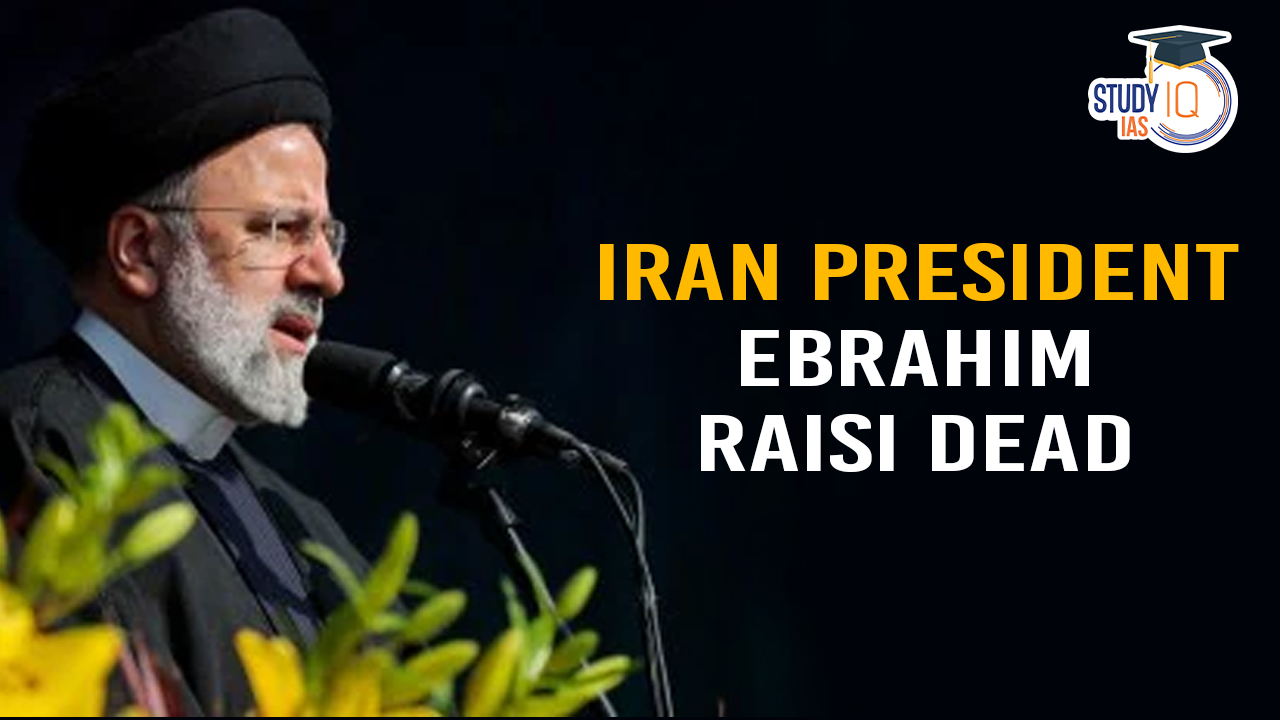Table of Contents
Iranian President Ebrahim Raisi and his foreign minister died when their helicopter crashed as it was crossing mountain terrain in heavy fog. This event has significant implications for Iran’s political landscape and its role in regional stability. Despite this, significant shifts in Iran’s policies are unlikely due to the continued authority of Supreme Leader Ayatollah Ali Khamenei. Check Out the details of India-Iran Reconnect in this article.
Iranian President Ebrahim Raisi Dies In Chopper Crash
Iran’s President Ebrahim Raisi and Foreign Minister Hossein Amirabdollahian were confirmed dead on May 20, 2024, following a helicopter crash in the East Azerbaijan province of Iran. The helicopter, a decades-old Bell 212 manufactured in the United States, went down in dense fog, killing all eight people on board, including the crew. This tragic accident has drawn attention to the longstanding issues plaguing Iran’s aviation sector, primarily attributed to extensive international sanctions.
Are US Sanctions Behind Iran’s Aviation Crisis?
Sanctions, primarily imposed by the United States, have critically impaired Iran’s ability to maintain and upgrade its aviation fleet. These sanctions have barred Iran from purchasing new aircraft or parts for existing ones, contributing to a decline in aviation safety. The restrictions, which prohibit Iran from importing any planes or equipment containing more than 10% US-made components, have left Iran with an aging and increasingly unreliable fleet.
Details of Helicopter Crash
The helicopter was en route from an event with Azerbaijani President Ilham Aliyev when it encountered severe fogging, rain, and low temperatures, leading to the crash. Paul Beaver, an aviation expert, noted that the challenging weather conditions likely played a significant role in the incident. The crash site, located between the cities of Varzaqan and Jolfa, was difficult to access, delaying rescue operations.
Victims
In addition to President Raisi and Foreign Minister Amirabdollahian, the crash also resulted in the deaths of:
- Malek Rahmati, East Azerbaijan Governor
- Mohammad Ali Ale-Hashem, Representative of the Supreme Leader in East Azerbaijan
- Mehdi Mousavi, Head of the Presidential Guard
- The helicopter’s pilot, co-pilot, and crew
Search and Rescue Efforts
Adverse weather conditions hampered the search for the wreckage, but the Iranian Red Crescent confirmed that rescue teams reached the crash site. Unfortunately, they found no signs of life among the helicopter’s occupants, with some bodies reportedly burned beyond recognition.
Iran has received offers of assistance from several countries in the region, including Turkey and Russia, who provided drones and other equipment to aid in the search efforts. The show of solidarity underscores the regional impact of the tragedy.
Transition of Power After Death of Iranian President Raisi
Following President Ebrahim Raisi’s death in a helicopter crash, Iranian Vice President Mohammad Mokhber has assumed the role of acting president, as mandated by the constitution. Mokhber will manage government operations and oversee the organization of a new presidential election within 50 days. This transition period is crucial for maintaining stability and continuity in Iran’s governance, ensuring that executive functions continue smoothly until a new president is elected.
Key Political and Military Actions
- Nuclear Programme: Iran doubled down on its nuclear programme after the US, under Donald Trump, withdrew from the P-5+1 deal.
- Even under Joe Biden, the pact remained in disarray.
- Support for Russia: Post-February 2022, after Russia invaded Ukraine, Iran maintained an anti-US and anti-West approach, supporting Russia.
- Crackdown on Protests: In late 2022, Iran witnessed protests triggered by Mahsa Amini’s death, leading to a brutal crackdown by the Raisi regime.
- Conflict with Israel: Iran’s direct attack on Israel in response to an Israeli attack on its consulate in Syria, which killed a top Iranian military officer.
- Support for Regional Groups: Active support to Hezbollah, Houthis, and Hamas, impacting regional peace and stability.
Regional Dynamics and Recent Events
- Hamas-Israel Conflict: Since October 7, when Hamas attacked Israel, Iran’s influence has been under scrutiny. The attack was perceived as having Tehran’s support.
- Saudi-Iran Rapprochement: Efforts for rapprochement between Saudi Arabia and Iran, brokered by China, have stalled, especially post-Hamas attacks.
Implications for Iran’s Foreign Policy
The death of Iranian President Ebrahim Raisi has significant implications for Iran’s foreign policy:
- Continuity and Stability: Vice President Mohammad Mokhber’s assumption of power ensures continuity, but uncertainties remain about policy shifts until a new president is elected.
- Relations with Regional Allies: Raisi’s death might temporarily affect Iran’s relations with regional allies like Hezbollah and Hamas, as he played a key role in these partnerships.
- Impact on Rapprochement Efforts: The recent rapprochement between Iran and Saudi Arabia, facilitated by Raisi, may face scrutiny and potential delays in further diplomatic initiatives.
- Nuclear Negotiations: Ongoing nuclear negotiations with world powers could experience delays or changes in stance, depending on the new administration’s priorities.
- China and Russia Ties: Iran’s strategic partnerships with China and Russia, strengthened under Raisi, might be reevaluated, impacting economic and military collaborations.
- Western Relations: The U.S. and European countries will closely watch the transition, potentially influencing sanctions and diplomatic engagements based on Iran’s new leadership and policies.
Global Reactions on Death of Iranian President
The death of Iranian President Ebrahim Raisi in a helicopter crash has elicited widespread global reactions:
- Regional Condolences: Middle Eastern countries, including Saudi Arabia, Turkey, and Iraq, expressed condolences and offered support. Hamas and Hezbollah praised Raisi’s support for the Palestinian cause.
- Global Leaders’ Tributes: Leaders like India’s Prime Minister Narendra Modi and Venezuela’s President Nicolas Maduro conveyed their condolences, highlighting Raisi’s contributions to bilateral relations.
- International Concerns: China and the U.S. showed restraint but expressed concern, acknowledging Raisi’s role in Iran’s strategic policies and regional influence.
- Support for Stability: The Gulf Cooperation Council and other international organizations stressed the importance of stability and continuity in Iran during the transition period.
India-Iran Relations
- India and Iran share a long history of interactions. The Friendship Treaty of 1950 and subsequent high-level exchanges have strengthened bilateral relations.
- PM Modi’s visit in 2016 and President Hassan Rouhani’s reciprocal visit in 2018 led to the “Civilizational Connect, Contemporary Context” statement.
- Strategic Engagements: India views Iran as part of its extended neighbourhood, engaging closely with Tehran on various issues.
- Recent Diplomatic Engagements:
- BRICS Summit Meeting: In August 2023, Indian PM Narendra Modi met Raisi in Johannesburg, discussing the long-term contract on Chabahar.
- Signed Contracts: Last week, a 10-year contract was signed between New Delhi and Tehran for Chabahar Port.
- Engagements by EAM: Frequent interactions with Iranian Foreign Minister Amir Hossein Amirabdollahian have secured key Indian interests, including the release of Indian sailors.
Future Outlook
- Succession Uncertainty: Following Raisi’s death, the focus will be on the succession plan for Iran’s presidency and supreme leadership.
- India’s Diplomatic Vigilance: India will closely monitor the intense lobbying within Iran’s political system for the top positions, assessing the implications for regional stability and its bilateral interests.
Way Forward
Following President Ebrahim Raisi’s untimely death, Iran faces a critical juncture requiring a smooth transition of power to Vice President Mohammad Mokhber and the timely organization of presidential elections. Maintaining policy continuity, reassuring international partners, and effectively managing the immediate aftermath are paramount. Strengthening institutional resilience will be vital for navigating this period of uncertainty and ensuring stability and progress for Iran’s future.


 Daily Quiz 01 July 2025
Daily Quiz 01 July 2025
 Special Intensive Revision (SIR) of Elec...
Special Intensive Revision (SIR) of Elec...
 National Doctor’s Day 2025: History, T...
National Doctor’s Day 2025: History, T...





















